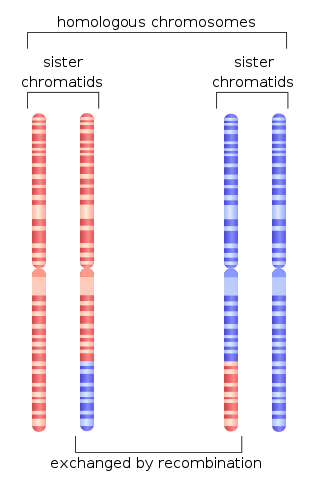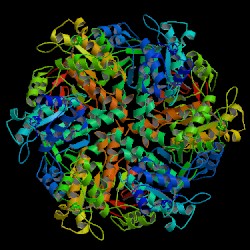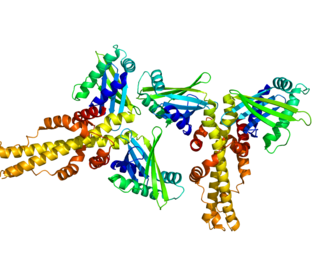DNA repair protein XRCC2 is a protein that in humans is encoded by the XRCC2 gene. [5] [6] [7]
DNA repair protein XRCC2 is a protein that in humans is encoded by the XRCC2 gene. [5] [6] [7]
This gene encodes a member of the RecA/Rad51-related protein family that participates in homologous recombination to maintain chromosome stability and repair DNA damage. This gene is involved in the repair of DNA double-strand breaks by homologous recombination and it functionally complements Chinese hamster irs1, a repair-deficient mutant that exhibits hypersensitivity to a number of different DNA-damaging agents. [7]
The XRCC2 protein is one of five human paralogs of RAD51, including RAD51B (RAD51L1), RAD51C (RAD51L2), RAD51D (RAD51L3), XRCC2 and XRCC3. They each share about 25% amino acid sequence identity with RAD51 and each other. [8]
The RAD51 paralogs are all required for efficient DNA double-strand break repair by homologous recombination and depletion of any paralog results in significant decreases in homologous recombination frequency. [9]
XRCC2 forms a four-part complex with three related paralogs: BCDX2 (RAD51B-RAD51C-RAD51D-XRCC2) while two paralogs form a second complex CX3 (RAD51C-XRCC3). These two complexes act at two different stages of homologous recombinational DNA repair. The BCDX2 complex is responsible for RAD51 recruitment or stabilization at damage sites. [9] The BCDX2 complex appears to act by facilitating the assembly or stability of the RAD51 nucleoprotein filament.
The CX3 complex acts downstream of RAD51 recruitment to damage sites. [9] The CX3 complex was shown to associate with Holliday junction resolvase activity, probably in a role of stabilizing gene conversion tracts. [9]
XRCC2 has been shown to interact with RAD51L3, [10] [11] [12] [13] Bloom syndrome protein [11] and RAD51C. [13] [14]
There are two known epigenetic causes of XRCC2 deficiency that appear to increase cancer risk. These are methylation of the XRCC2 promoter and epigenetic repression of XRCC2 by over-expression of EZH2 protein.
The XRCC2 gene was found to be hypermethylated in the promoter region in 52 of 54 cases of cervical cancer. [15] Promoter hypermethylation reduces gene expression, and thus would reduce the tumor suppressing homologous recombinational repair otherwise supported by XRCC2.
Increased expression of EZH2 leads to epigenetic repression of RAD51 paralogs, including XRCC2, and thus reduces homologous recombinational repair. [16] This reduction was proposed to be a cause of breast cancer. [16] EZH2 is the catalytic subunit of Polycomb Repressor Complex 2 (PRC2) which catalyzes methylation of histone H3 at lysine 27 (H3K27me) and mediates gene silencing of target genes via local chromatin reorganization. [17] EZH2 protein is up-regulated in numerous cancers. [17] [18] EZH2 mRNA is up-regulated, on average, 7.5-fold in breast cancer, and between 40% and 75% of breast cancers have over-expressed EZH2 protein. [19]

Homologous recombination is a type of genetic recombination in which genetic information is exchanged between two similar or identical molecules of double-stranded or single-stranded nucleic acids.
Recombinases are genetic recombination enzymes.

DNA repair protein RAD51 homolog 1 is a protein encoded by the gene RAD51. The enzyme encoded by this gene is a member of the RAD51 protein family which assists in repair of DNA double strand breaks. RAD51 family members are homologous to the bacterial RecA, Archaeal RadA and yeast Rad51. The protein is highly conserved in most eukaryotes, from yeast to humans.

Ku70 is a protein that, in humans, is encoded by the XRCC6 gene.

Double-strand break repair protein MRE11 is an enzyme that in humans is encoded by the MRE11 gene. The gene has been designated MRE11A to distinguish it from the pseudogene MRE11B that is nowadays named MRE11P1.

DNA repair protein XRCC3 is a protein that in humans is encoded by the XRCC3 gene.

Checkpoint protein HUS1 is a protein that in humans is encoded by the HUS1 gene.

Bloom syndrome protein is a protein that in humans is encoded by the BLM gene and is not expressed in Bloom syndrome.

Flap endonuclease 1 is an enzyme that in humans is encoded by the FEN1 gene.

RAD52 homolog , also known as RAD52, is a protein which in humans is encoded by the RAD52 gene.

DNA repair protein RAD51 homolog 2 is a protein that in humans is encoded by the RAD51L1 gene.

RAD51 homolog C , also known as RAD51C, is a protein which in humans is encoded by the RAD51C gene.

DNA repair protein RAD51 homolog 4 is a protein that in humans is encoded by the RAD51L3 gene.

DNA repair and recombination protein RAD54-like is a protein that in humans is encoded by the RAD54L gene.

Meiotic recombination protein DMC1/LIM15 homolog is a protein that in humans is encoded by the DMC1 gene.

E3 ubiquitin-protein ligase FANCL is an enzyme that in humans is encoded by the FANCL gene.

Non-homologous end-joining factor 1 (NHEJ1), also known as Cernunnos or XRCC4-like factor (XLF), is a protein that in humans is encoded by the NHEJ1 gene. XLF was originally discovered as the protein mutated in five patients with growth retardation, microcephaly, and immunodeficiency. The protein is required for the non-homologous end joining (NHEJ) pathway of DNA repair. Patients with XLF mutations also have immunodeficiency due to a defect in V(D)J recombination, which uses NHEJ to generate diversity in the antibody repertoire of the immune system. XLF interacts with DNA ligase IV and XRCC4 and is thought to be involved in the end-bridging or ligation steps of NHEJ. The yeast homolog of XLF is Nej1.

DNA repair and recombination protein RAD54B is a protein that in humans is encoded by the RAD54B gene.

Partner and localizer of BRCA2, also known as PALB2 or FANCN, is a protein which in humans is encoded by the PALB2 gene.

A double-strand break repair model refers to the various models of pathways that cells undertake to repair double strand-breaks (DSB). DSB repair is an important cellular process, as the accumulation of unrepaired DSB could lead to chromosomal rearrangements, tumorigenesis or even cell death. In human cells, there are two main DSB repair mechanisms: Homologous recombination (HR) and non-homologous end joining (NHEJ). HR relies on undamaged template DNA as reference to repair the DSB, resulting in the restoration of the original sequence. NHEJ modifies and ligates the damaged ends regardless of homology. In terms of DSB repair pathway choice, most mammalian cells appear to favor NHEJ rather than HR. This is because the employment of HR may lead to gene deletion or amplification in cells which contains repetitive sequences. In terms of repair models in the cell cycle, HR is only possible during the S and G2 phases, while NHEJ can occur throughout whole process. These repair pathways are all regulated by the overarching DNA damage response mechanism. Besides HR and NHEJ, there are also other repair models which exists in cells. Some are categorized under HR, such as synthesis-dependent strain annealing, break-induced replication, and single-strand annealing; while others are an entirely alternate repair model, namely, the pathway microhomology-mediated end joining (MMEJ).